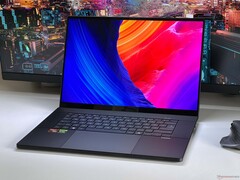The Asus ProArt P16 is the creative sibling of the gaming laptop ROG Zephyrus G16. The chassis is pretty much identical, but the ProArt P16 waives the lid illumination and the metal surfaces are black. The biggest difference, however, can be found on the inside. While the Zephyrus G16 is available with more powerful vapor chamber cooling solutions for faster GPUs all the way up the RTX 5090 Laptop, the ProArt P16 is only available with the traditional heat-pipe cooling. This means the fastest GPU is the GeForce RTX 5070 Laptop, which is still equipped with 8 GB VRAM and the performance advantage over the old RTX 4070 Laptop.
In addition to the small performance gains, the limited VRAM can quickly become a bottleneck, especially when you edit pictures or videos. We do not understand why Asus does not offer the ProArt with faster GPU options since the cooling solution of the Zephyrus G16 is available. Simply switching to the Zephyrus is not an option for all users, either, because only the ProArt offers a touchscreen with stylus support.
This brings us to the second big topic, the screen. The 2024 model was equipped with a high-resolution 4K OLED, but the frequency was limited to just 60 Hz. Asus now uses a 120 Hz OLED, but the resolution is lower (2880 x 1800) and the slightly grainy picture on on bright contents due to the touch layer is still visible. Asus once again offers accurate color profiles for sRGB as well as P3, but the problem is the limited brightness. In SDR mode, we only measure 360 nits and only 430 nits in HDR mode. Many competitors with OLED screens are superior in this respect, not to mention Mini-LED panels.
All in all, the ProArt P16 is still a very good multimedia laptop, but Asus could have closed the gap to the MacBook Pro 16 with a brighter OLED screen as well as a GPU with more VRAM. Please see our comprehensive review of the new ProArt P16 for more information including benchmarks.










